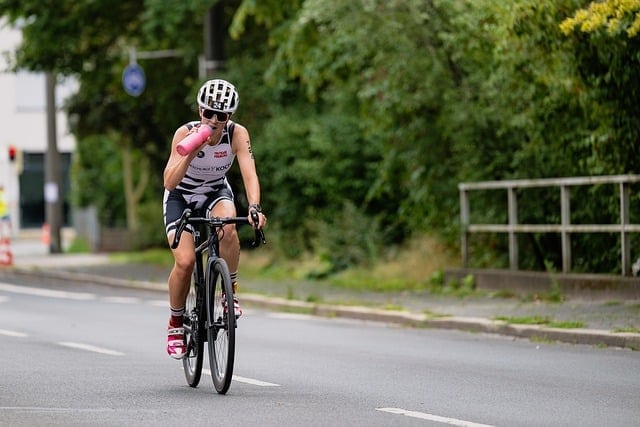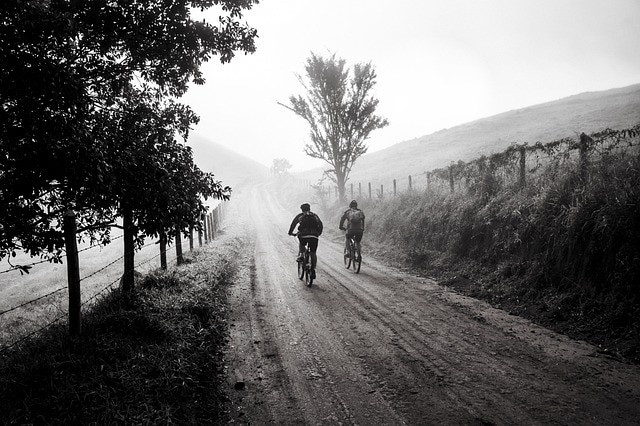
The average speed on a road bike is between 10-12 mph over flat terrain. By using simple math, it takes an average of about 50 minutes to bike 10 miles at a steady pace. The true duration will vary from cyclist to cyclist, mainly depending on their skill and experience on the craft.
When I first started cycling, to bike 10 miles seemed like a lot. Half the time I was tired. To ride for an extended period was tough. But when I made it, I was very happy with myself. To bike 10 miles, a bit of physical preparation is required, but it is generally a realistic goal for everyone in decent shape and with a good mountain bike or road bike.
However, there are many factors that can alter your cycling speed, some of these are physical, some psychological. some are environmental and some are purely technical. In this article, I´ll take a look at a variety of these factors and fits, so that the next time you go out for a ride, you can pedal toward your goal as fast as you can.
Table of Contents
There are an incredible number of factors that can affect how fast you go. Here are the main ones:
These factors deal with the technical aspect of cycling a bike, meaning it focuses purely on the experience of riding a bike and your relationship with it.

The bike type you choose may determine a lot. A bike rack with a variety of choices can really help as different bikes have diverse average speeds. Let´s take a look.
This type of bike is the quintessential bike for medium to long distances. Due to a lighter weight and skinnier wheels, it can be an average 10-30% faster than a mountain bike and can be about 15% faster using the same energy output on flat paved surfaces.
Top speed; 12-22 mph (Takes 30-50 minutes to cycle 10 miles).
This bike is ideal for rougher, mountainous terrains. Their thick tires and heavy weight are ideal for keeping good balance and withstanding the elements. Mountain bikes are a great example of a tough bike, but it can only cover a certain distance.
Top speed: 8-12 mph. (Takes about one hour to cycle 10 miles).
These bikes are perfect for those who easily get tired or want to ride for long distances. If you´re not in peak physical condition, you can alternate to electrical power to recover. With these bikes you can ride very quickly making them very convenient and the most comfortable option.
Top Speed: 12-18 mph (Takes anywhere between 30 to 50 minutes to cycle 10 miles).
These bikes are ideal for sightseeing and just cycling around. However, they can reach decent speeds for a nice bike ride.
Top speed: 12-15 mph. (It takes around 40 minutes to 1 hours to cycle 10 miles).
Cycling discipline comes down to how you choose to expend your energy while cycling. It is crucial that you feel comfortable with the bike you´re riding. Otherwise, the ride could be unpleasant and not as productive as it could be.
If your bike is not in it´s best shape, it won´t be so easy or enjoyable to ride. Be sure to keep it well-maintained.
The purpose of the bike ride will determine a lot. For example, in a competition you would end up riding to the best of your ability, whereas with training you might take it a bit lighter.
Physical health can greatly impact how well one can ride. Here are some aspects to take note of:

When it comes to how long does it take to cycle 10 miles, your body is the key factor. The rhythm and the intensity of your pedaling will determine how fast you will go. Therefore, to go as fast as possible, you need to be in good physical shape.
When it comes to how long does it take to ride 10 miles. The difference in average distance covered between a seasoned and an amateur biker can be astonishing. The main contrast is physical condition and proper training.
Riding style and technique can seriously affect how fast you go. For example, you could choose to ride on your feet for a while or to remain seated for the whole bike ride. Both your energy and speed will be affected by how you choose to ride, so it is important to think about.
Weight and age definitely affect how fast you go. The heavier the weight on the bike, the more challenging and physically demanding it is to cycle. Age is also a big factor. Younger people have more energy and are in better shape. For older people and kids riding can be a bit tougher on the body.
After a while of pedaling, biking could quickly get very tiring and uncomfortable, something which could potentially affect your time. A remedy for this is having a good bike seat. It is key for comfort, especially on long distance trails with mountain bikes and road bikes.
With cycling, Fitness affects the quality of your biking trail. Your state of overall fitness can heavily impact your performance as well. Luckily, cycling can have plenty of benefits. One is that it helps you lose weight.
The environment also affects how one can ride. Here are the main factors that affect your bike journey on any given day:
Terrain is one of the main factors that affect how fast you can cycle. It shapes the landscape and more importantly will determine how much energy you´ll need to complete your 10 miles.
If the terrain is rugged, it can be a challenge to ride through it.
When the road goes uphill, you go against gravity, making the climb physically strenuous and considerably slower than flat terrain.
Downhill riding goes with gravity, it doesn´t take much effort and you can reach great speeds. It can be a very enjoyable experience, so much so that many people enjoy downhill riding.
Weather will shape and condition the riding. Whether it is raining, snowing or incredibly hot, they´ll all have an impact on your performance.
The ideal conditions for biking are mild to warm temperatures with good visibility and no humidity. It can also depend on personal taste, as everyone has different preferences.
There could be obstacles on the road which could hinder your progress while biking. A road with many curves could prove difficult to maneuver and could considerably slow you down.
If you´re looking to practice to increase your speed, avoid places where there are many obstacles.
When you're going biking, it is always important to be aware of how the environment and terrain changes, as it´ll help you avoid painful accidents.
Being familiar with the route can give you an edge during training or a speed trial. You´ll know what to expect and based on that, you can administer your energy usage.
Knowing what to expect and practicing consistently may help you go faster over time.
Psychology can also have an impact on your speed. With good confidence and work, your speed will seriously improve.

Having confidence can also determine your speed. If you´re not confident, you might hesitate and possibly slow down as a result.
To have enough confidence when cycling you´ll have to gain some experience and become familiar with the environment that you practice in. Once you get the hang of it, you´ll improve.
Developing the skill of cycling is essential to improving your speed. By becoming an active person, with more practice and regular training on two wheels, you´ll find your groove and go faster.
With skill, your energy usage will become more efficient, helping you improve over time.
As you can see, there are a number of factors that can impact your biking journey. To have the best possible spin, it is important that you pay attention to all these factors, and react accordingly.
Don´t forget that to bike 10 miles as quickly as possible or even just to reach the distance, you´ll need to prepare. Start by doing a couple of miles every day and repeating the same distance constantly. You can slowly increase the intensity or your training.
So, how long does it take to bike 10 miles? The answer is up to you. With a good pace, preparation and proper conditions, it could be as fast as 30 minutes or less. Conversely, it could also take up to two hours for beginners in a tough environment. It all depends on the average speed you maintain.
The best way to reach this goal is by starting out small. If you like cycling, you can do one mile a day and build from there.
